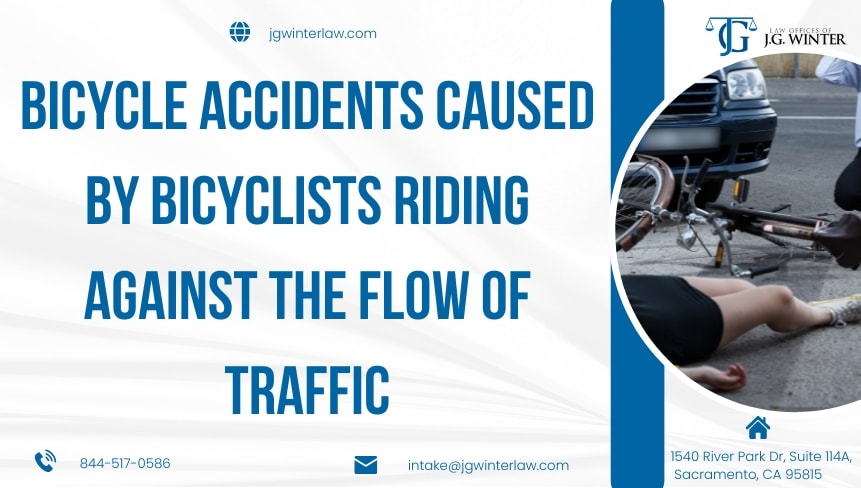One of the major causes of bike accidents is bicyclists riding against the flow of traffic. The “wrong-way cycling” poses considerable risks to the cyclists, motorists, and pedestrians. Riding in the opposite direction of traffic disrupts the expected norms of road use, reducing reaction times and increasing potential for collisions. The legal implications of such behavior are substantial, as wrong-way cycling violates traffic laws and can lead to severe consequences in an accident. J.G. Winter Law recognizes the importance of educating cyclists about these risks and the legal consequences. Bicycle accident lawyers guide cyclists towards safer practices and provide expert legal assistance in unfortunate bicycle accidents.
Understanding the risks of wrong-way cycling
Riding against traffic, commonly known as wrong-way cycling, is highly dangerous. It disrupts the predictable flow of traffic and significantly increases the chances of collisions. Cycling opposite the traffic flow goes against most drivers’ expectations, making it harder for them to react appropriately to cyclists.
Traffic dynamics and visibility issues
Wrong-way cycling severely impacts visibility and reaction times. Cyclists riding against traffic become less visible to drivers, especially at intersections and driveways. Motorists typically scan for traffic coming from the usual direction, not expecting cyclists from the opposite way. It leads to shorter reaction times for both parties, making it difficult to avoid sudden collisions.
Statistics of bicycle accidents involving wrong-way bicycling
Cycling against traffic flow is more common than one might expect. The statistics below highlight the serious risks associated with wrong-way bicycling and emphasize the importance of cycling in the correct direction.
- According to NHTSA, about 32% of cyclists involved in a crash were U.S. riding against traffic, with the number increasing to 42% at intersections.
- In 15% of those against-traffic bicycle crashes, the cyclist riding the wrong way was specifically listed as the contributing factor to the
crash. Bicyclist failure to yield was a factor in 21% of the crashes, and stop sign violations were a factor in 8%. - 81.8%, cyclists collide with the front of a vehicle, leading to severe injuries from bumper or hood impacts.
- Nearly 31% of all bicycle injuries from collisions with motor vehicles occur in the evening and early morning hours, between 6 p.m. and 6 a.m.
- The peak time for bicyclist injuries and fatalities is between 3 p.m. and 6 p.m., accounting for 28.8% of incidents, with the highest number of fatalities occurring between 6 p.m. and 9 p.m., making up 22.3% of the total.
Preventative measures and best practices
To reduce bicycle accidents caused by bicyclists riding against the flow of traffic, cyclists can adopt several preventative measures and best practices. Adhering to these recommendations enhances personal safety and contributes to the overall well-being of the cycling community and road users.
Safe cycling practices
Adopting safe cycling habits is crucial for avoiding accidents:
- Ride in the Designated Lane: Always use the designated bike lane or ride on the right side of the road in the direction of traffic to ensure visibility and predictability.
- Stay Visible: Wear bright or reflective clothing, and use lights and reflectors, especially during dawn, dusk, or night.
- Use Hand Signals: Clearly signal your intentions to turn or stop so that motorists can anticipate your movements.
- Be Alert at Intersections: Extra caution is required at intersections. Make eye contact with drivers and be aware of turning vehicles.
- Regularly Check Your Bicycle: Ensure your bike is in good working condition, paying attention to brakes, tires, and lights.
Public awareness and education
Educational campaigns and programs are vital in informing both cyclists and motorists about the dangers of bycycling against the traffic flow. These initiatives can include workshops, community rides, and distribution of safety materials. Schools and local community groups can collaborate to spread awareness, especially among new and young cyclists. Moreover, incorporating safe cycling habits into driver’s education programs can enhance mutual understanding and respect on the road.
Cycle smart: Understanding the importance of traffic direction

Adhering to the correct flow of traffic while cycling is not just a legal requirement; it’s a fundamental aspect of road safety. Riding in the same direction as other vehicles significantly reduces the risk of accidents and ensures better visibility for cyclists. Cyclists must understand that following traffic rules, including proper lane usage and signaling, is crucial in safeguarding themselves and fellow road users.
J.G. Winter Law advocates for the safety of cyclists. If you or someone you know has been involved in a bicycle accident involving wrong-way cycling, our personal injury attorney Jeremy G Winter can help you navigate the legal complexities and protect your rights. Contact us today for a free consultation.
FAQs
Should bicyclists ride with the flow of traffic and as near to the right side of the road as possible?
Bicyclists should ride with the flow of traffic and stay as close to the right side of the road as practicable. It enhances visibility and predictability, making it safer for both cyclists and motorists. However, cyclists may move away from the right edge to avoid obstacles or when preparing for a left turn.
What are some hazards a driver might encounter when driving around cyclists?
Drivers may encounter several hazards around cyclists, including cyclists suddenly entering the road from a driveway, making unexpected turns or lane changes, and encountering cyclists in blind spots, especially when turning or changing lanes.
What are the most common motorist caused car bicycle crashes?
The most common motorist-caused car-bicycle crashes include right hook accidents (motorist turns right across the path of a cyclist), dooring (opening a car door into a cyclist’s path), rear-end collisions, and left turn accidents (motorist turns left in front of an oncoming cyclist).
Can I cycle in the opposite direction?
No, you must not cycle in the opposite direction because it is unsafe and often illegal. It can reduce visibility and reaction time for both cyclists and motorists, increasing the risk of accidents.
Is it illegal to ride a bike against traffic in California?
In California, it is illegal to ride a bike against the direction of traffic. Bicyclists are required to ride in the same direction as other vehicles to enhance safety and compliance with traffic laws.
Do you bike on the right side of the road?
You should bike on the right side of the road, in the same direction as the traffic flow. It increases predictability and visibility, making it safer for cyclists and motorists alike.
Should bicycles signal when turning on the roadway?
Bicycles should signal when turning on the roadway. Using hand signals to indicate left or right turns or stopping is important for safety. It informs other road users of the cyclist’s intentions, allowing for safer maneuvering and reducing the risk of collisions.


